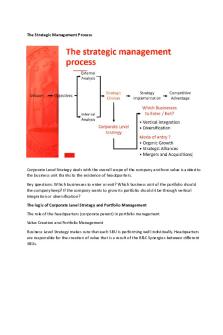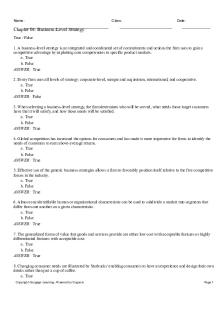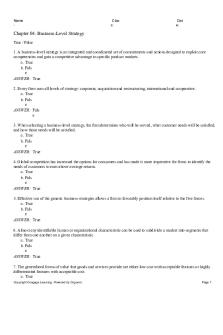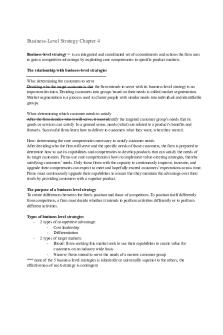3 - Business level strategy PDF

| Title | 3 - Business level strategy |
|---|---|
| Author | Carl Bauert |
| Course | Introduction to Management |
| Institution | Eidgenössische Technische Hochschule Zürich |
| Pages | 3 |
| File Size | 88.7 KB |
| File Type | |
| Total Downloads | 39 |
| Total Views | 789 |
Summary
Matteo Rosada Zambelli Strategy strategy: strategy designed for a firm or a division of a firm that competes within a single business. Types of competitive advantage and Sustainability Porter present three generic strategies to overcome the five forces and achieve competitive advantage. Generic stra...
Description
Matteo&Rosada&Zambelli&
&
12/10/16&
Business-level*Strategy* * Ø Business-level*strategy:&strategy&designed&for&a&firm&or&a&division&of&a&firm&that&competes&within&a& single&business.& ! Types!of!competitive!advantage!and!Sustainability! Ø Porter&present&three&generic&strategies&to&overcome&the&five&forces&and&achieve&competitive& advantage.& Ø Generic*strategies:&analysis&of&business&strategy&into&basic&types&based&on&breadth&of&target&market& and&type&of&competitive&advantage.& & Overall!Cost!leadership& Ø A&firm’s&generic&strategy&based&on&appeal&to&the&market&using&competitive&advantage&based&on&low& cost.& Ø Requires:& 1. Aggressive&construction&of&efficient-scale&facilities.& 2. Vigorous&pursuit&of&cost&reductions&from&experience.& 3. Tight&cost&and&overhead&control.& 4. Avoidance&of&marginal&customer&accounts.& 5. Cost&minimisation&in&all&the&value&chain.& Ø The&key&is&the&experience*curve:&business&learns&to&lower&costs&as&it&gains&experience&with& production&process.& Ø Firm&must&attain&competitive*parity:&a&firm’s&achievement&of&similarity,&with&competitors&with& respect&to&low&cost&and&differentiation.& Ø Low-cost&leadership&enables&a&firm&to&achieve&above-average&returns&despite&strong&competition.& Ø Low-cost&leadership&protects&from&competitors&and&buyers.&Allows&also&for&more&flexibility&to&cope& with&demands&from&suppliers.& Ø Potential&dangers&of&overall&cost&leadership&strategy&include:& 1. Too&much&focus&on&one&or&a&few-value&chain&activities& 2. All&competitors&share&a&common&input&or&raw&material&(firm&vulnerable&to&increase&cost)& 3. Strategy&is&imitated&too&easily& 4. Lack&of&parity&on&differentiation&(must&provide&similar&quality)& 5. Erosion&of&cost&advantages&when&the&pricing&information&available&to&customers&increases& (eg.&Through&internet&customers&can&see&many&prices).& & Differentiation& Ø A&firm’s&generic&strategy&based&on&creating&differences&in&the&firm’s&product&offering&by&creating& something&that&is&perceived&as&unique&and&valued&by&customers.& Ø Some&examples&include:&brand&image&and&prestige,&technology,&innovation,&customer&service…& Ø Firms&achieve&and&sustain&differentiation&advantages&when&their&price&premiums&exceed&the&extra& costs&in&being&unique.& Ø Provides&protection&against&rivalry,&avoids&the&need&for&a&low-cost&position&and&provides&higher& margins.& Ø Differentiation&enhances&customer&loyalty&reducing&threat&from&substitutes.& Ø Potential&dangers&of&differentiation&strategy&include:& 1. Uniqueness&that&is¬&valuable& 2. Too&much&differentiation& 3. Too&high&a&price&premium& 4. Differentiation&is&easily&imitated& 5. Dilution&of&brand&identification&through&product-line&extensions.&(add&low&cost&product&will& not&bring&benefits&in&the&long&run&eg.&Gucci)& 6. Perceptions&of&differentiation&may&vary&between&buyers&and&sellers.& &
&
1
Matteo&Rosada&Zambelli& Focus& Ø Ø Ø Ø Ø Ø Ø
&
12/10/16&
A&firm’s&generic&strategy&based&on&appeal&to&a&narrow&market&segment&within&an&industry.& Cost*focus:&firm&tries&to&create&a&cost&advantage&in&its&target&segment.& Cost*focus:&firm&tries&to&create&a&cost&advantage&in&its&target&segment.& Differentiation*focus:&firm&tries&to&create&cost&advantage&in&its&target&market.& Requires&firm&to&have&a&low-cost&position&with&its&strategic&target,&high&differentiation&or&both.& Used&to&select&markets&that&are&less&vulnerable&to&substitutes&or&where&competitors&are&weaker.& Potential&dangers&of&focus&strategies&include:& 1. Erosion&of&cost&advantages&within&the&narrow&segment&(cost&advantages&may&be&null&over& time)& 2. Product&and&service&offerings&that&are&highly&focused&are&subject&to&competition&from&new& entrants&and&from&imitation.& 3. Focusers&can&become&too&focused&to&satisfy&buyer&needs.&
& Combination!Strategies:!Integrating!Overall!Low!Cost!and!Differentiation! Ø Combination*strategies:&enables&a&firm&to&provide&two&types&of&values&to&customers&à& differentiated&products&and&lower&prices.& Ø Goal&is&to&provide&unique&value&to&customers&in&an&efficient&manner.& Ø Firms&that&integrate&low&cost&and&differentiation&are&in&a&dominant&competitive&position.& Ø Reduces&head&to&head&rivalry&such&as&protracted&price&wars& Ø Potential&dangers&of&integrating&overall&cost&leadership&and&differentiation&include:& 1. Firms&that&fail&to&attain&both&strategies&may&end&up&with&neither&and&will&be&stuck&in&the& middle.& 2. Underestimating&the&challenges&and&expenses&associated&with&coordinating&value-creating& activities&in&the&extended&value&chain.&(high&investment&in&financial&and&human&resources)& 3. Miscalculating&sources&of&revenue&and&profit&pools&in&the&firm’s&industry.& Ø Three&strategies&to&integrate&overall&low&cost&and&differentiation.& & Automated!and!Flexible!Manufacturing!systems& Ø Mass*customisation:&firm’s&ability&to&manufacture&unique&products&in&small&quantities&at&low&costs.& Ø Possible&due&to&the&advances&in&manufacturing&technologies.& & Exploiting!the!Profit!Pool!Concept!for!Competitive!Advantage& Ø Profit*pool:&the&total&profits&in&an&industry&at&all&points&along&the&value&chain.& Ø Profit&pool&will&be&deeper&in&some&segments&of&the&value&chain&than&in&others,&and&the&depth&will& vary&within&an&individual&segment.& & Coordinating!the!Extended!Value!Chain!by!Way!of!Information!Technology& Ø Firms&have&achieved&success&by&integrating&activities&throughout&the&extended&value&chain&using& information&technology&to&link&their&own&value&chain&with&the&value&chains&of&customers&and& suppliers.& Ø Profit&pool&will&be&deeper&in&some&segments&of&the&value&chain&than&in&others,&and&the&depth&will& vary&within&an&individual&segment.& & Industry!life!cycle!stages:!Strategic!implications! Ø Industry*life*cycle:&the&stages&of&introduction,&growth,&maturity&and&decline&that&occur&over&the&life& cycle&of&an&industry.& Ø Managers&have&great&attention&to&production&efficiencies&and&process&engineeringàlower&costs.& Ø Managers&must&attain&a&level&of&parity&in&all&functional&areas.& & Strategies!in!the!Introduction!Stage& Ø Introduction*stage:&products&are&unfamiliar&to&customers,&market&segments¬&well&defined,& unspecified&product&features,&low&sales&growth,&operating&losses&and&need&for&financial&support.&
&
2
Matteo&Rosada&Zambelli&
&
12/10/16&
Ø Success&requires&emphasis&on&R&D&and&marketing.& Ø Challenges&are:& 1. Developing&the&product&and&finding&a&way&to&get&users&to&try&it& 2. Generating&enough&exposure&so&that&the&product&emerges&to&the&standard&of&others.& & Strategies!in!the!Growth!Stage& Ø Growth*stage:&strong&increase&in&sales,&growing&competition,&developing&brand&recognition&and& need&to&finance&complementary&value&chain&activities&as&marketing,&customer&service&and&R&D.& Ø Efforts&directed&toward&stimulating&selective&demand.& Ø Revenues&increase&because:& 1. New&customers&are&trying&the&product& 2. Growing&proportion&of&satisfied&customers&are&making&repeat&purchases.& & Strategies!in!the!Maturity!Stage& Ø Maturity*stage:&slowing&demand&growth,&saturated&markets,&direct&competition,&price&competition& and&strategic&emphasis&on&efficient&operations.& Ø Becomes&more&difficult&for&firms&to&differentiate&their&offerings.& Ø Managers&can&use&two&positioning&strategies&to&affect&consumer’s&mental&shifts:& 1. Reverse&positioning:&a&break&in&industry&tendency&by&offering&products&with&fewer&features& and&lower&prices:& 2. Breakaway&positioning:&a&break&in&industry&tendency&by&offering&products&that&are&still&in& the&industry&but&are&perceived&by&customers&as&being&different.& & Strategies!in!the!Decline!Stage! Ø Decline&stage:&falling&sales&and&profits,&increasing&price&competition&and&industry&consolidation.& Ø Changes&in&consumers&taste&push&a&product&to&decline.& Ø Products&in&the&decline&stage&consume&a&lot&of&management&time&and&financial&resources.& Ø Four&basic&strategies&are&available&in&the&decline&phase:& 1. Maintaining:*keep&the&product&going&without&reducing&support&and&development&with&the& hope&that&competitors&will&exit&the&market.& 2. Harvesting:&obtaining&as&much&profit&as&possible&in&short/medium&term&and&reduce&costs.& 3. Exiting:&dropping&the&product.& 4. Consolidation:&acquiring&or&merging&with&other&firms&in&the&industry&to&increase&market& power.& & & & & & & & & ! ! ! &
&
3...
Similar Free PDFs

3 - Business level strategy
- 3 Pages

Business Level strategy
- 14 Pages

Business level strategy Samsung
- 5 Pages

CH 4 - Business Level Strategy
- 9 Pages

3. Corporate Level Strategy
- 18 Pages

Chapter 04 Business Level Strategy
- 21 Pages

Chapter 04 Business Level Strategy
- 25 Pages

Business Strategy
- 60 Pages

Business Strategy
- 12 Pages
Popular Institutions
- Tinajero National High School - Annex
- Politeknik Caltex Riau
- Yokohama City University
- SGT University
- University of Al-Qadisiyah
- Divine Word College of Vigan
- Techniek College Rotterdam
- Universidade de Santiago
- Universiti Teknologi MARA Cawangan Johor Kampus Pasir Gudang
- Poltekkes Kemenkes Yogyakarta
- Baguio City National High School
- Colegio san marcos
- preparatoria uno
- Centro de Bachillerato Tecnológico Industrial y de Servicios No. 107
- Dalian Maritime University
- Quang Trung Secondary School
- Colegio Tecnológico en Informática
- Corporación Regional de Educación Superior
- Grupo CEDVA
- Dar Al Uloom University
- Centro de Estudios Preuniversitarios de la Universidad Nacional de Ingeniería
- 上智大学
- Aakash International School, Nuna Majara
- San Felipe Neri Catholic School
- Kang Chiao International School - New Taipei City
- Misamis Occidental National High School
- Institución Educativa Escuela Normal Juan Ladrilleros
- Kolehiyo ng Pantukan
- Batanes State College
- Instituto Continental
- Sekolah Menengah Kejuruan Kesehatan Kaltara (Tarakan)
- Colegio de La Inmaculada Concepcion - Cebu






